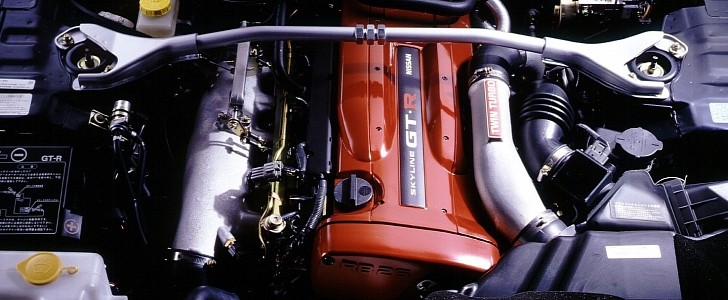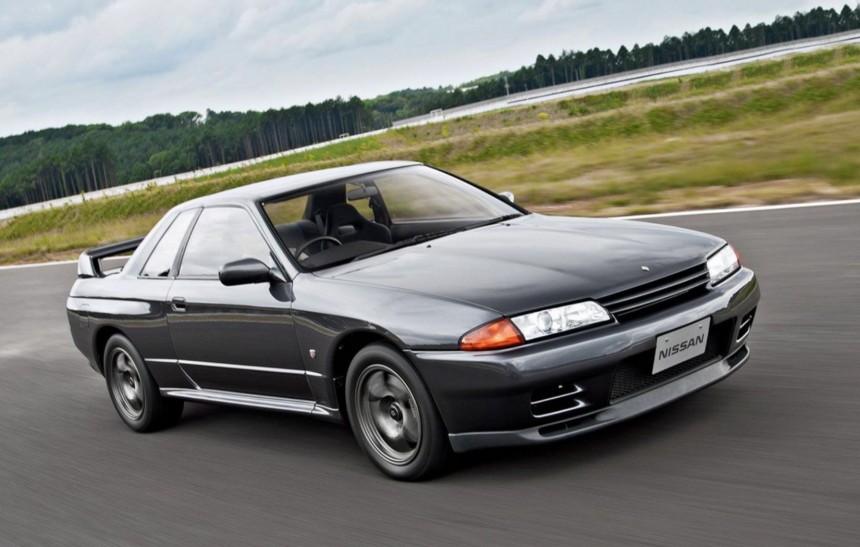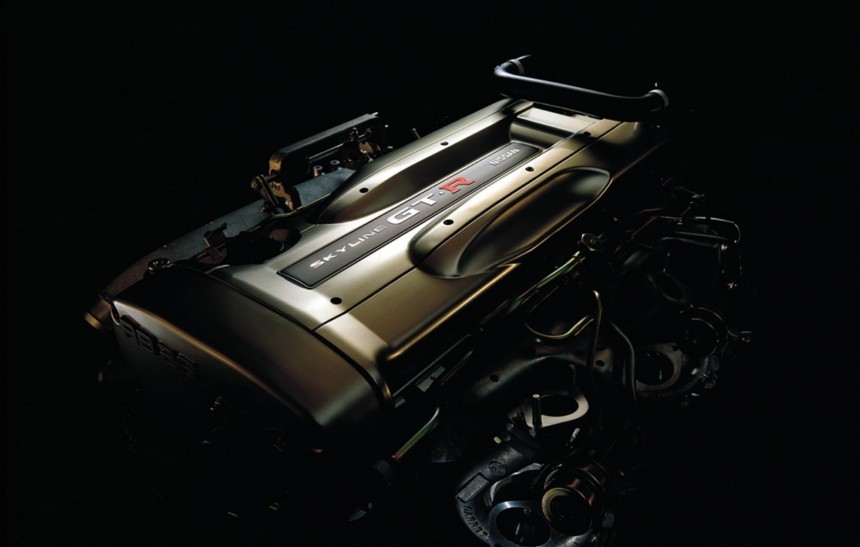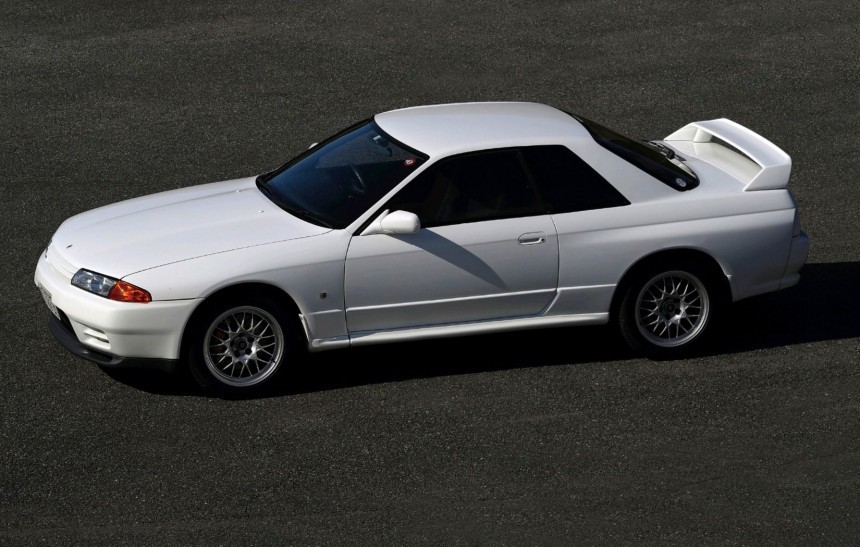Produced by Nissan from 1989 to 2002, the unit at the heart of three Skyline GT-R generations is among the greatest straight sixes ever created.
The origins of this amazing motor can be traced back to the mid-1980s when Nissan introduced a new family of oversquare straight-six gasoline units dubbed Response Balance (RB). Built around a cast-iron block, the first iteration (RB20E) displaced 2.0 liters and featured an aluminum head with two valves per cylinder, operated by a single overhead camshaft. It debuted on the fifth-generation Laurel sedan and could initially develop a little over 120 hp.
A turbocharged version followed (RB20ET), then, in 1989, all RB versions received a redesigned cylinder head and the new ECCS (Electronic Concentrated Control System) electronic injection system. Apart from the entry-level engine, which continued to use a single camshaft design, all other second-generation RB20s were now fitted with two camshafts, as well as four valves per cylinder.
That year, after a sixteen-year hiatus, the Japanese manufacturer released a new high-performance GT-R variant of its iconic Skyline model. The brainchild of chief engineer Naganori Ito, the car was developed for FIA Group A racing and was set to replace the struggling R31 GTS-R.
Based on the eight-generation, two-door R32 chassis, it was equipped with a revamped multi-link suspension and a motorsport-oriented version of the famed ATTESA (Advanced Total Traction Engineering System for All-Terrain) all-wheel-drive system.
The highlighting feature of this incredible car was the newly developed engine called Response Balance 2600cc DOHC Electronic Twin Turbo or RB26DETT, for short. Nissan Kohki (the company’s powertrain engineering and manufacturing facility) originally tested a twin-turbo 2.4-liter based on a bored and stroked version of the RB20 but ultimately ended up increasing the displacement to 2.6 liters.
Like its smaller siblings, the new powerplant featured a cast-iron block and an aluminum head, which contained four valves per cylinder. However, these components were thoroughly redesigned for increased power and reliability. Furthermore, instead of a single throttle body, it was equipped with six individual units - three sets of dual throttle assemblies, to be exact - attached to the side of the block. It also used cast pistons with cooling channels under the crowns, I-beam conrods, and a parallel twin-turbo system that included a pair of intercooled, Garrett T25 turbochargers with ceramic impellers.
Linked to a five-speed manual, it was rated at 276 hp at 6,800 rpm, and 260 lb-ft (353 Nm) of torque at 4,400 rpm, reigning supreme among all other RB variants, but the mighty engine was capable of more.
Back then, all major Japanese carmakers had a gentleman’s agreement to restrict the output of domestic models to 276 hp. This was done to increase safety during a period where fatal road accidents were at an all-time high in Japan.
To tame the RB26, Nissan engineers installed a boost restrictor. Of course, owners quickly figured how to remove it and tinker with the ECU, revealing that it could actually produce well over 300 hp.
Seven months after the R32 GT-R went into production, Nissan unveiled the Group A homologation model officially known as GT-R Nismo. This version was lighter, more aerodynamically efficient, and its engine came with steel turbine impellers instead of the ceramic versions that proved to be unreliable.
As you would expect, the output didn’t change on the road-legal Nismos (on paper, at least) but the competition-spec editions of the engine (like the RB26DETT N1), could spit out between 450 and 600 hp, highlighting the true potential of this amazing motor. This was made possible by a host of race-grade goodies such as a RENIK-designed block with thicker cylinder walls and enhanced water-cooling channels, stronger internals, and upgraded ancillaries.
In the motorsport world, the R32 GT-R Nismo became an icon by winning all 29 races of the Japanese Touring Car Championship from 1989 to 1993. It also crossed the finish line first at the 1991 Spa 24 Hour race and annihilated the competition in Australia’s Group A Championship, where it earned the name “Godzilla.”
The race-spec RB26DETT N1 made its way in a road-legal GT-R in the summer of 1991, when the carmaker released the limited-edition Nismo N1. The engine continued to be offered in the years that followed on the V-Spec (Victory Specification) N1 and the V-Spec II N1 trims.
In 1995, Nissan unveiled the R33 GT-R. Considered by many the black sheep of the GT-R lineage because of its styling, longer wheelbase, or added weight, it used nearly identical engine configurations as its predecessor.
Things changed in 1997 when Nismo introduced the 400R. Produced in just 44 copies, this ultra-rare R33 was powered by a completely revamped version of the RB26 called RBX-GT2. Developed and built by REINIK, it featured a custom crankshaft, slightly larger forged pistons, upgraded conrods, polished ports, high lift camshafts, an upgraded oil system, larger exhaust manifolds, and higher output turbochargers connected to a new intercooler designed by Nismo.
The RBX-GT2 ignored the gentleman’s agreement by producing 400 hp (298 kW) and 347 lb-ft (470 Nm). This enabled the 400R to sprint to 60 mph (0-97 kph) from a standstill in 4.0 seconds and reach a top speed of over 186 mph (300 kph).
In 1999, Nissan released the fifth, last, and best version of the Skyline GT-R. Based on the new R34 chassis, it came with a slightly improved RB26 in both standard and N1 configurations. The most important changes were the use of ball-bearing center sections on both turbochargers and the addition of a dual-mass flywheel. Adorned with candy red cam covers, the powerplant was now linked to a Getrag 233 six-speed manual.
Produced until 2003, it reached mind-blowing levels of performance thanks to the tuning scene. With a wide range of aftermarket components to choose from and limited only by their imagination, many enthusiasts managed to squeeze more than 900 hp out of this formidable unit.
An engineering masterpiece from an era when engines were built to last, the RB26 proved its superiority on both the street and the track, becoming not just a JDM icon but one of the most iconic engines ever built.
In the video below posted on YouTube by That Racing Channel, you can see an R34 Skyline GT-R roaming the streets with a 1,100-hp RB26DETT under the hood.
A turbocharged version followed (RB20ET), then, in 1989, all RB versions received a redesigned cylinder head and the new ECCS (Electronic Concentrated Control System) electronic injection system. Apart from the entry-level engine, which continued to use a single camshaft design, all other second-generation RB20s were now fitted with two camshafts, as well as four valves per cylinder.
That year, after a sixteen-year hiatus, the Japanese manufacturer released a new high-performance GT-R variant of its iconic Skyline model. The brainchild of chief engineer Naganori Ito, the car was developed for FIA Group A racing and was set to replace the struggling R31 GTS-R.
The highlighting feature of this incredible car was the newly developed engine called Response Balance 2600cc DOHC Electronic Twin Turbo or RB26DETT, for short. Nissan Kohki (the company’s powertrain engineering and manufacturing facility) originally tested a twin-turbo 2.4-liter based on a bored and stroked version of the RB20 but ultimately ended up increasing the displacement to 2.6 liters.
Like its smaller siblings, the new powerplant featured a cast-iron block and an aluminum head, which contained four valves per cylinder. However, these components were thoroughly redesigned for increased power and reliability. Furthermore, instead of a single throttle body, it was equipped with six individual units - three sets of dual throttle assemblies, to be exact - attached to the side of the block. It also used cast pistons with cooling channels under the crowns, I-beam conrods, and a parallel twin-turbo system that included a pair of intercooled, Garrett T25 turbochargers with ceramic impellers.
Back then, all major Japanese carmakers had a gentleman’s agreement to restrict the output of domestic models to 276 hp. This was done to increase safety during a period where fatal road accidents were at an all-time high in Japan.
To tame the RB26, Nissan engineers installed a boost restrictor. Of course, owners quickly figured how to remove it and tinker with the ECU, revealing that it could actually produce well over 300 hp.
Seven months after the R32 GT-R went into production, Nissan unveiled the Group A homologation model officially known as GT-R Nismo. This version was lighter, more aerodynamically efficient, and its engine came with steel turbine impellers instead of the ceramic versions that proved to be unreliable.
As you would expect, the output didn’t change on the road-legal Nismos (on paper, at least) but the competition-spec editions of the engine (like the RB26DETT N1), could spit out between 450 and 600 hp, highlighting the true potential of this amazing motor. This was made possible by a host of race-grade goodies such as a RENIK-designed block with thicker cylinder walls and enhanced water-cooling channels, stronger internals, and upgraded ancillaries.
In the motorsport world, the R32 GT-R Nismo became an icon by winning all 29 races of the Japanese Touring Car Championship from 1989 to 1993. It also crossed the finish line first at the 1991 Spa 24 Hour race and annihilated the competition in Australia’s Group A Championship, where it earned the name “Godzilla.”
In 1995, Nissan unveiled the R33 GT-R. Considered by many the black sheep of the GT-R lineage because of its styling, longer wheelbase, or added weight, it used nearly identical engine configurations as its predecessor.
Things changed in 1997 when Nismo introduced the 400R. Produced in just 44 copies, this ultra-rare R33 was powered by a completely revamped version of the RB26 called RBX-GT2. Developed and built by REINIK, it featured a custom crankshaft, slightly larger forged pistons, upgraded conrods, polished ports, high lift camshafts, an upgraded oil system, larger exhaust manifolds, and higher output turbochargers connected to a new intercooler designed by Nismo.
The RBX-GT2 ignored the gentleman’s agreement by producing 400 hp (298 kW) and 347 lb-ft (470 Nm). This enabled the 400R to sprint to 60 mph (0-97 kph) from a standstill in 4.0 seconds and reach a top speed of over 186 mph (300 kph).
Produced until 2003, it reached mind-blowing levels of performance thanks to the tuning scene. With a wide range of aftermarket components to choose from and limited only by their imagination, many enthusiasts managed to squeeze more than 900 hp out of this formidable unit.
An engineering masterpiece from an era when engines were built to last, the RB26 proved its superiority on both the street and the track, becoming not just a JDM icon but one of the most iconic engines ever built.
In the video below posted on YouTube by That Racing Channel, you can see an R34 Skyline GT-R roaming the streets with a 1,100-hp RB26DETT under the hood.





















